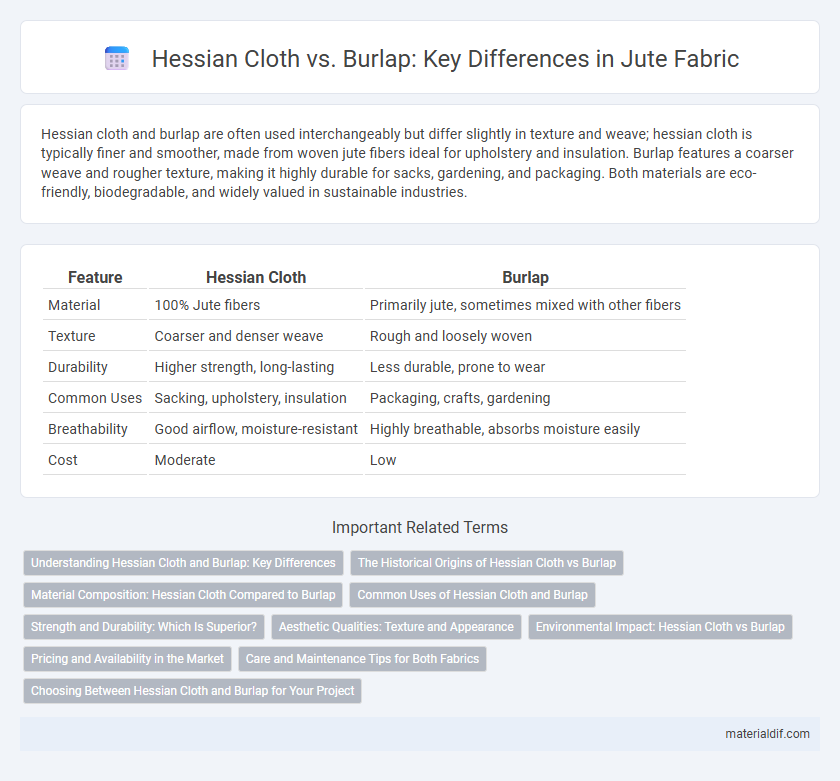Hessian cloth and burlap are often used interchangeably but differ slightly in texture and weave; hessian cloth is typically finer and smoother, made from woven jute fibers ideal for upholstery and insulation. Burlap features a coarser weave and rougher texture, making it highly durable for sacks, gardening, and packaging. Both materials are eco-friendly, biodegradable, and widely valued in sustainable industries.
Table of Comparison
| Feature | Hessian Cloth | Burlap |
|---|---|---|
| Material | 100% Jute fibers | Primarily jute, sometimes mixed with other fibers |
| Texture | Coarser and denser weave | Rough and loosely woven |
| Durability | Higher strength, long-lasting | Less durable, prone to wear |
| Common Uses | Sacking, upholstery, insulation | Packaging, crafts, gardening |
| Breathability | Good airflow, moisture-resistant | Highly breathable, absorbs moisture easily |
| Cost | Moderate | Low |
Understanding Hessian Cloth and Burlap: Key Differences
Hessian cloth and burlap are both woven fabrics made from jute fibers, commonly used for packaging, agriculture, and upholstery. Hessian cloth typically features a tighter weave, providing greater durability and a smoother texture compared to the coarser, loosely woven burlap. Understanding these differences is crucial for selecting the appropriate fabric based on strength, texture, and application needs.
The Historical Origins of Hessian Cloth vs Burlap
Hessian cloth originated in the 19th century, primarily produced in Europe, named after the German state of Hesse, where it was initially manufactured for military uniforms before evolving into a textile for sacks and upholstery. Burlap, derived from the jute plant primarily in South Asia, traces its historical use to ancient civilizations for packaging and storage due to its coarse, durable fibers. Both textiles share a common material base but diverge in their cultural origins and traditional applications, with Hessian reflecting European industrialization and Burlap rooted in indigenous agrarian practices.
Material Composition: Hessian Cloth Compared to Burlap
Hessian cloth and burlap are both produced from jute fibers, but hessian undergoes a finer weaving process that results in a softer and smoother texture compared to the coarser and rougher burlap fabric. The material composition of hessian typically features tightly woven jute strands, enhancing durability and flexibility, whereas burlap is woven more loosely, which makes it more breathable but less uniform. These differences in material composition influence their respective applications, with hessian favored for upholstery and decoration while burlap is commonly used for sacks and agricultural purposes.
Common Uses of Hessian Cloth and Burlap
Hessian cloth is commonly used in upholstery, sacks for agricultural products, and as backing material in carpet manufacturing due to its durable, breathable texture. Burlap, often made from jute, is widely utilized in gardening for soil erosion control, plant protection, and as bags for storing and transporting coffee beans and potatoes. Both materials offer eco-friendly, biodegradable alternatives for packaging and industrial applications.
Strength and Durability: Which Is Superior?
Hessian cloth, made from tightly woven jute fibers, offers superior strength and durability compared to burlap, which is loosely woven and more prone to tearing. The denser weave of hessian cloth provides enhanced resistance to wear, making it ideal for heavy-duty applications such as upholstery and industrial packaging. Burlap's coarse texture and lower tensile strength limit its use to lighter tasks like gardening and decorative purposes.
Aesthetic Qualities: Texture and Appearance
Hessian cloth features a finer weave and smoother texture, offering a more polished, uniform appearance compared to burlap's coarser, rougher surface with visible large fibers. Burlap's loosely woven fabric displays a rustic, natural aesthetic with a rugged, earthy charm favored for casual and decorative uses. The tactile differences make hessian suitable for refined crafts where subtle texture is desired, while burlap provides a bold, organic look for upholstery and rustic decor.
Environmental Impact: Hessian Cloth vs Burlap
Hessian cloth and burlap, both made from jute fibers, differ slightly in environmental impact due to their production and usage. Hessian cloth typically undergoes a finer weaving process, which may require more water and energy compared to the rougher burlap, though both materials remain biodegradable and renewable alternatives to synthetic fabrics. The sustainable cultivation of jute contributes to soil health and carbon sequestration, making both hessian and burlap eco-friendly choices with minimal chemical processing.
Pricing and Availability in the Market
Hessian cloth generally commands a higher price point than burlap due to its finer weave and durability, making it preferred for industrial and decorative applications. Burlap is more widely available and cost-effective, produced in larger quantities primarily for agricultural and packaging uses. Market availability fluctuates based on regional production, but burlap remains the dominant choice where affordability and bulk supply are prioritized.
Care and Maintenance Tips for Both Fabrics
Hessian cloth and burlap, both derived from jute fibers, require specific care to maintain durability; hessian should be air-dried away from direct sunlight to prevent fiber brittleness, while burlap benefits from gentle hand washing with mild detergent to avoid fraying. Storing these fabrics in a dry, well-ventilated area reduces the risk of mold and mildew growth, essential for prolonging their lifespan. Regular dusting or vacuuming with a brush attachment helps preserve the texture and appearance of both materials.
Choosing Between Hessian Cloth and Burlap for Your Project
Hessian cloth and burlap, both made from jute fibers, differ primarily in weave density and texture, affecting their suitability for various projects. Hessian cloth features a finer, tighter weave ideal for upholstery, crafts, and decorative applications requiring durability and a smoother finish, while burlap boasts a coarser, looser weave perfect for gardening, sack materials, and rustic decor where breathability and rough texture are beneficial. Selecting between them depends on project requirements for aesthetic appeal, strength, and breathability, with hessian cloth offering refined appearance and burlap providing rugged versatility.
Hessian Cloth vs Burlap Infographic

 materialdif.com
materialdif.com